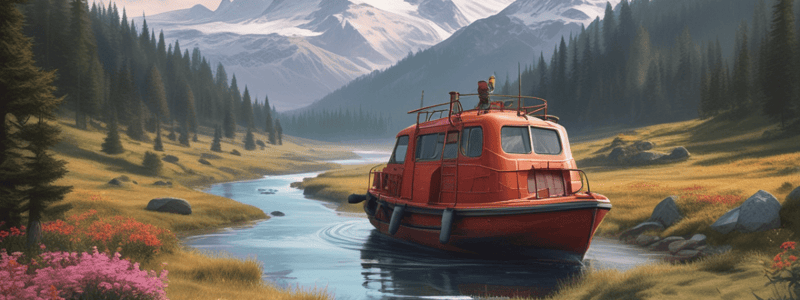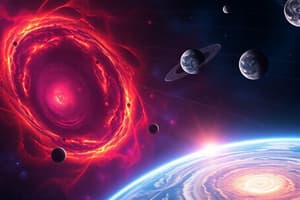Podcast
Questions and Answers
What is the estimated age of our solar system?
What is the estimated age of our solar system?
- 4.5 billion years (correct)
- 5,000 years
- 5,000 million years
- 10,000 million years
What is an asteroid?
What is an asteroid?
- A small planet in our solar system
- A piece of rock that orbits the Moon
- A comet that has lost its tail
- A piece of rock left over from the formation of the solar system (correct)
What is a comet composed of?
What is a comet composed of?
- Mostly liquid water
- Mostly rock and metal
- Mostly liquid gas
- Mostly frozen gas, with small amounts of dust (correct)
What is the shape of the Earth?
What is the shape of the Earth?
How many natural satellites does the Earth have?
How many natural satellites does the Earth have?
How long does it take the Moon to orbit the Earth?
How long does it take the Moon to orbit the Earth?
What is the distance between the Earth and the Moon?
What is the distance between the Earth and the Moon?
What was the ancient astronomers' initial understanding of the universe's structure?
What was the ancient astronomers' initial understanding of the universe's structure?
What is the source of light that allows us to see the Moon?
What is the source of light that allows us to see the Moon?
How long does the Moon take to complete its orbit around the Earth?
How long does the Moon take to complete its orbit around the Earth?
Why does the sun appear to rise and set?
Why does the sun appear to rise and set?
How many hours does it take the Earth to make one complete turn on its axis?
How many hours does it take the Earth to make one complete turn on its axis?
How many time zones are there in the world?
How many time zones are there in the world?
What is the result of the Earth's rotation on its axis?
What is the result of the Earth's rotation on its axis?
What is the main difference between the geocentric and heliocentric models of the universe?
What is the main difference between the geocentric and heliocentric models of the universe?
What is the reason we can see the Moon in the sky?
What is the reason we can see the Moon in the sky?
What is the cause of day and night on Earth?
What is the cause of day and night on Earth?
How does the Earth's rotation affect different parts of the world?
How does the Earth's rotation affect different parts of the world?
What is the significance of the 24 time zones on Earth?
What is the significance of the 24 time zones on Earth?
Flashcards are hidden until you start studying
Study Notes
Formation of the Solar System
- The solar system formed about 5,000 million years ago from a dense cloud of interstellar gas and dust.
- The cloud collapsed, possibly due to the shockwave of a nearby exploding star, called a supernova.
- Material clumped together due to gravity, forming planetesimals, which eventually collided to form planets and moons.
The Earth
- The Earth is roughly spherical in shape, confirmed by observations from ground level, aircraft, and spacecraft.
- The spherical shape of the Earth causes various phenomena that a flat Earth would not.
The Moon
- The Moon is the only natural satellite of Earth and is not a planet.
- The Moon orbits the Earth approximately once every 30 days and is 239,000 miles away from the Earth.
Phases of the Moon
- The Moon is not a light source and does not create its own light.
- We can only see the Moon because it reflects light from the Sun.
- The lunar cycle repeats itself every 30 days.
Day and Night
- The sun appears to rise and set due to the Earth's rotation on its axis.
- The Earth makes one complete turn every 24 hours and rotates towards the east.
- It is night in some parts of the world while it is day in other parts.
- The world is divided into 24 different time zones, one for each hour in a day.
Asteroids and Comets
- An asteroid is a piece of rock left over from the time when the solar system formed.
- Asteroids move in an orbit around the Sun.
- Comets are objects made out of mostly frozen gas, with small amounts of dust, and are often called "dirty snowballs".
The Solar System
- Our solar system consists of the Sun, the planets, their moons, asteroids, and comets.
- All 8 planets orbit the Sun, which sits in the center.
Ancient Astronomy
- Ancient astronomers believed in the geocentric model, where the Earth is at the center of the universe.
- We now know that the sun is at the center of the universe, and the planets move in orbits around it, called the heliocentric model.
Formation of the Solar System
- The solar system formed about 5,000 million years ago from a dense cloud of interstellar gas and dust.
- The cloud collapsed, possibly due to the shockwave of a nearby exploding star, called a supernova.
- Material clumped together due to gravity, forming planetesimals, which eventually collided to form planets and moons.
The Earth
- The Earth is roughly spherical in shape, confirmed by observations from ground level, aircraft, and spacecraft.
- The spherical shape of the Earth causes various phenomena that a flat Earth would not.
The Moon
- The Moon is the only natural satellite of Earth and is not a planet.
- The Moon orbits the Earth approximately once every 30 days and is 239,000 miles away from the Earth.
Phases of the Moon
- The Moon is not a light source and does not create its own light.
- We can only see the Moon because it reflects light from the Sun.
- The lunar cycle repeats itself every 30 days.
Day and Night
- The sun appears to rise and set due to the Earth's rotation on its axis.
- The Earth makes one complete turn every 24 hours and rotates towards the east.
- It is night in some parts of the world while it is day in other parts.
- The world is divided into 24 different time zones, one for each hour in a day.
Asteroids and Comets
- An asteroid is a piece of rock left over from the time when the solar system formed.
- Asteroids move in an orbit around the Sun.
- Comets are objects made out of mostly frozen gas, with small amounts of dust, and are often called "dirty snowballs".
The Solar System
- Our solar system consists of the Sun, the planets, their moons, asteroids, and comets.
- All 8 planets orbit the Sun, which sits in the center.
Ancient Astronomy
- Ancient astronomers believed in the geocentric model, where the Earth is at the center of the universe.
- We now know that the sun is at the center of the universe, and the planets move in orbits around it, called the heliocentric model.
Studying That Suits You
Use AI to generate personalized quizzes and flashcards to suit your learning preferences.






